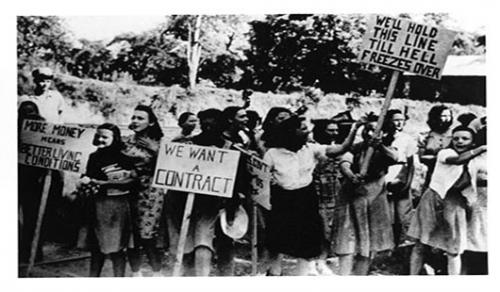The Biggest Strike in US History:
Posted by Pete on Sep 17th 2020
This month in 1934, the biggest strikes in US history swept through the American textile industry. It’s an enduring example of how collective action against exploitation is the pathway to a better world.

The election of Franklin Delano Roosevelt in 1932 was only the beginning of a struggle.
A wide coalition of the American working class had chosen for itself a president who would, to an extent, back them.
But this didn’t mean the bosses were beat.

Enabled by a series of laissez-faire Republicans in the 1920s – Harding, Coolidge, Hoover – big business had run rampage through the US economy.
Then the Wall Street Crash and the Great Depression which followed it made American voters more open to new ideas about the distribution of wealth and economic power.
This openness raised up figures like Huey Long, and ultimately helped FDR into the White House.
But the promise of a New Deal and its delivery were different things.
FDR’s economic innovations faced legal challenges from the Right throughout the 1930s but they were also met with widespread non-compliance by bosses on the ground.
In the textile industry, bosses systematically ignored FDR’s new industrial codes encouraging cooperation with labor unions, the increase of wages and the regulation of hours.
What’s more, the federal government did little to stop them.
American textile workers from Georgia to Pennsylvania were being screwed over, and FDR’s White House didn’t intend to help them.
It was time for the workers to take matters into their own hands.
In May 1934, mill bosses across the country extended working hours without a wage increase and the National Recovery Administration (a New Deal body) did nothing.
The United Textile Workers (UTW) union, which had 250,000 members, threatened to strike.

Various UTW locals went on strike over the following months.
Then, on 10 th August, a striker called Reuben Sanders was killed in a street battle with strikebreakers in Columbus, Georgia. Eight thousand mourners attended his funeral.
The UTW called a special convention of its members in New York, which drew up a series of demands for the union:
- A 30-hour week
- A minimum wage
- Union recognition
- The reinstatement of blacklisted union members
The delegates voted overwhelmingly to strike nationwide unless these simple demands were met by 1 st September 1934.
The fat cat mill owners didn’t budge.
As September began, the textile strike swept the industry.
‘Flying squadrons’ of picketers drove from mill to mill, bringing out workers. One organizer declared:
Within just a week, 400,000 workers were out on strike. The American textile industry was shut down – it was the biggest strike in US history.
Terrified by this display of workers’ collective power, the US ruling class struck back with brute force.
Encouraged by mill bosses, reactionary governors across the striking states deployed the National Guard against UTW laborers.
Ibra Blackwood called the Guard out in South Carolina with orders to shoot to kill picketers who attempted to enter mills. Six UTW men were later murdered in the state, most of them shot in the back.
Governor Eugene Talmadge effectively turned Georgia into a police state in the third week of September, interning strikers in WWI-era prisoner of war camps to await trial by military tribunal.
The state terror paid off. Starving and brutalized, the textile strikers began to trickle back to work.

To this day, people often ask why the labor movement is so weak in the US and why the country lacks party of labor.
The simple answer is repression.
Throughout the 20 th century, and especially during the years between the First and Second World War, the American Left was brutalized by a thuggish alliance between the state and big business.
The arrests of Eugene Debs and the anti-war movement under Woodrow Wilson, the harassment of socialists like Paul Robeson, the absurd Red Scare under McCarthy – it’s a long and sorry story of authoritarian violence and intimidation.
But the Textile Strike of 1934 shows us why it happens. The one percent at the top are terrified of the power of workers when they come together and demand their rights as noble and dignified human beings.
As Pete Seeger liked to sing,
